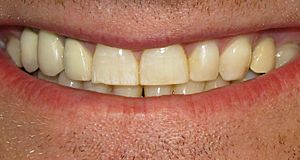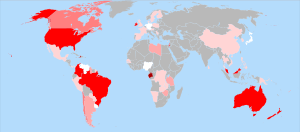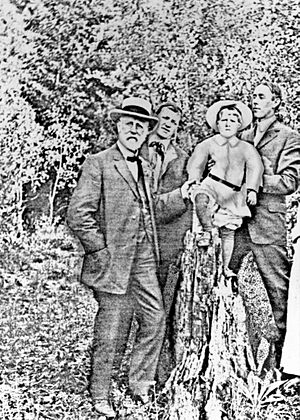Water fluoridation facts for kids
Water fluoridation is when a small, controlled amount of fluoride is added to a public water supply. The main reason for doing this is to help reduce tooth decay. Water that has fluoride in it helps prevent cavities. This can happen naturally, or by adding fluoride.
Fluoride works on the surface of your teeth. When it's in your saliva, it helps stop your tooth enamel from breaking down. It also helps your teeth rebuild their minerals in the early stages of cavities. Adding fluoride to drinking water is usually done with a special compound. In the U.S., this costs about $1.26 per person each year. If water naturally has too much fluoride, it needs to be removed. The World Health Organization (WHO) suggests a fluoride level between 0.5 and 1.5 mg/L (milligrams per liter). This amount can change depending on the climate and other fluoride sources.
Tooth decay is a big problem for public health in many countries. It affects most schoolchildren and adults. Adding fluoride to water helps reduce cavities in children. It's less clear how much it helps adults. A study by Cochrane found that water fluoridation reduced cavities by 35% in baby teeth and 26% in permanent teeth for children who didn't get fluoride from other places.
Many European countries have seen a big drop in tooth decay. They often use fluoride in milk or salt instead of water. Some recent studies suggest that water fluoridation might not be needed as much now. This is because fluoride products like toothpaste are widely used.
Fluoridation can cause dental fluorosis. This might change how developing teeth look, but it's usually mild. It's not usually a big problem for how teeth look or for public health. There is no clear proof of other side effects from water fluoridation. The effect of fluoride depends on how much fluoride you get each day from all sources. Drinking water is usually the biggest source. Other ways to get fluoride include toothpaste, salt, and milk.
Adding fluoride to public water supplies started in the U.S. In 2012, 25 countries added fluoride to their water. In 11 of these, more than half the people drank fluoridated water. Another 28 countries have water that naturally contains fluoride. However, in many of these, the fluoride level is too high. In 2012, about 435 million people worldwide drank water with the right amount of fluoride. This is about 5.4% of the world's population. Major health groups like the World Health Organization and FDI World Dental Federation say water fluoridation is safe and works well. The Centers for Disease Control and Prevention (CDC) calls it one of the top ten public health achievements of the 20th century in the U.S.
Even with this support, some people disagree with adding fluoride to water. Some countries and communities have stopped it, while others have increased it. People who are against it say that the benefits and risks haven't been studied enough. They also debate if it's right to give medicine to everyone without their individual choice.
Contents
Why We Fluoridate Water

The main reason for water fluoridation is to stop tooth decay. This is done by adding the right amount of fluoride to public water. Tooth decay, also called dental caries, is one of the most common chronic diseases around the world. It usually isn't life-threatening, but it can cause pain. It can also make it hard to eat or speak. It can even affect how people feel about their appearance. This is especially true for children from poorer families.
In most developed countries, 60–90% of schoolchildren and most adults have tooth decay. The problem is growing in some developing countries. This is due to changes in diet and not enough fluoride. In the U.S., poorer people and minorities have more decayed or missing teeth. They also get less dental care. Once a cavity forms, the tooth often needs many fillings. Treating oral diseases is the fourth most expensive disease to treat. Adding fluoride to water or salt is similar to adding iodine to salt. Iodine helps prevent congenital hypothyroidism and goiter.
Water fluoridation aims to prevent a long-term disease that affects children and the poor the most. Another goal was to reduce differences in dental health and dental care between rich and poor people. Some studies suggest that fluoridation helps reduce these differences. However, the evidence is limited.
Health and dental groups around the world support water fluoridation. They say it is safe and effective. It started in 1945 after studies showed that fluoride naturally found in water helped prevent cavities. More research proved that small amounts of fluoride prevent tooth decay.
How Fluoridation Is Done
Adding fluoride does not change how drinking water looks, tastes, or smells. It's usually done by adding one of three compounds to the water:
- Sodium fluoride (NaF) was the first compound used. It's a white powder or crystal. It costs more but is easy to handle. Smaller water companies often use it.
- Fluorosilicic acid (H2SiF6) is the most common additive in the United States. It's a cheap liquid that comes from making phosphate fertilizer. Shipping can be expensive because it contains a lot of water.
- Sodium fluorosilicate (Na2SiF6) is a powder or fine crystal. It's easier to ship than fluorosilicic acid.
These compounds are chosen because they dissolve well, are safe, available, and cheap. A 1992 study in the U.S. found that most people (63%) received water with fluorosilicic acid. Sodium fluorosilicate was used for 28% of the population, and sodium fluoride for 9%.
Recommended Levels
The Centers for Disease Control and Prevention (CDC) has guidelines for water fluoridation. These cover how to manage staff, report information, train, inspect, and monitor the process. They also explain what to do if too much fluoride is added.
Fluoride was once thought to be an essential nutrient. However, the U.S. National Research Council no longer calls it that. This is because there aren't enough studies showing it's needed for human growth. Still, they consider it a "beneficial element" for teeth. The European Food Safety Authority also doesn't call it essential. But they recommend a daily intake because it helps prevent cavities. The recommended daily intake of fluoride from all sources is 0.05 mg/kg of body weight for both children and adults.
In 2011, the U.S. Department of Health and Human Services (HHS) lowered the recommended fluoride level to 0.7 mg/L. In 2015, the U.S. Food and Drug Administration (FDA) recommended that bottled water should not have more than 0.7 mg/L of fluoride.
Older recommendations from 1962 suggested levels from 0.7 to 1.2 mg/L. This depended on the average daily air temperature. Warmer places had lower recommended levels because people drink more water. These old standards might not be right for all parts of the world now. This is because of things like air conditioning and more use of soft drinks, processed food, and fluoridated toothpaste.
In 2011, the World Health Organization (WHO) said that 1.5 mg/L should be the highest limit. They also said 0.5 mg/L could be a good lower limit. An Australian study in 2007 suggested a range from 0.6 to 1.1 mg/L.
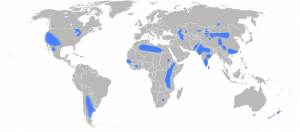

Where Fluoride is Found Naturally
Fluoride can be found naturally in water. Its levels can be above, at, or below recommended amounts. Rivers and lakes usually have less than 0.5 mg/L of fluoride. But groundwater, especially in volcanic or mountainous areas, can have as much as 50 mg/L. Higher amounts of fluorine are found in certain rocks. This fluorine then dissolves into nearby water as fluoride.
If natural fluoride levels are too high, it needs to be removed. This is called Defluoridation. It can be done by filtering water through materials like activated alumina or bone char. It can also be done by adding chemicals like alum or lime.
Many common pitcher or faucet filters do not remove fluoride. More expensive reverse osmosis filters remove 65–95% of fluoride. Distillation removes all fluoride. Some bottled waters have fluoride without saying so on the label. This fluoride can be natural or from a public water supply that was fluoridated. The FDA says that bottled water labeled as de-ionized, purified, demineralized, or distilled has little to no fluoride.
What the Studies Show
Studies show that water fluoridation reduces tooth decay. They also consistently show that it causes dental fluorosis. Most cases of fluorosis are mild and don't affect how teeth look. There is no clear proof of other bad effects. However, most research on other effects has not been of high quality.
How Well It Works
Studies have shown that water fluoridation reduces cavities in children. For adults, the results are less clear. Some studies find a benefit, while others do not. Studies in the U.S. in the 1950s and 1960s showed that water fluoridation cut childhood cavities by 50-60%. Later studies in 1989 and 1990 showed smaller reductions (40% and 18%). This is likely because people started using more fluoride from other sources, like toothpaste.
A UK study in 2000 found that water fluoridation was linked to a 15% drop in children with cavities. It also led to an average decrease of 2.25 decayed, missing, or filled baby teeth. A 2015 Cochrane study estimated that water fluoridation reduced cavities by 35% in baby teeth and 26% in permanent teeth for children without other fluoride sources. A 2020 study found that water fluoridation improved dental health and job outcomes.
Fluoride may also prevent cavities in adults. A 2007 study found that water fluoridation prevented about 27% of cavities in adults. A 2015 Cochrane study found no clear research on how well water fluoridation works for adults. A 2016 study found that stopping water fluoridation usually led to more cavities.
Most European countries have seen a big drop in cavities without water fluoridation. This is due to fluoride toothpaste and other fluoride products. For example, in Finland and Germany, cavity rates stayed low or kept falling even after water fluoridation stopped. This happened in communities where people got fluoride from other sources. However, water fluoridation is still needed in the U.S. Unlike most European countries, the U.S. doesn't have school dental care. Many children don't see a dentist regularly. For many U.S. children, fluoridated water is their main source of fluoride.
Dental Fluorosis
Fluoride's bad effects depend on the total amount of fluoride you get. At the recommended level, the only clear bad effect is dental fluorosis. This can change how children's teeth look while they are growing. But it's usually mild and doesn't really affect how teeth look or public health. In April 2015, the U.S. lowered the recommended fluoride levels to 0.7 ppm. This was done to reduce the risk of dental fluorosis. The 2015 Cochrane study estimated that at 0.7 ppm, about 12% of people would have fluorosis that might be a concern for how teeth look. This number goes up to 40% if you include all levels of fluorosis, even very mild ones. In the U.S., mild or very mild dental fluorosis has been reported in 20% of people. Moderate fluorosis is in 2%, and severe fluorosis in less than 1%.
The most important time for exposure is between ages one and four years. The risk ends around age eight. Fluorosis can be prevented by checking all sources of fluoride. Fluoridated water is responsible for about 40% of the risk. Other sources, especially toothpaste, cause the other 60%.
In many developed countries, fluorosis is increasing even in places without fluoridated water. This is mostly because children swallow toothpaste. In the U.S., as tooth decay went down, fluorosis went up in both fluoridated and non-fluoridated areas. Because of this, fluoride levels have been lowered in infant formulas, children's toothpaste, water, and fluoride supplements worldwide.
Safety
Fluoridation has little effect on the risk of bone fractures (broken bones). It might even slightly lower the risk compared to very high or no fluoridation.
There is no clear link between water fluoridation and cancer or cancer deaths. This is true for cancer in general and for bone cancer specifically. Many studies have found no connection between fluoride in water and bone cancer. Some concerns came from a 1990 study on male rats, but there's no strong evidence of fluoride causing cancer in humans.
Fluoride can naturally be found in water at levels much higher than recommended. This can cause several long-term problems. These include severe dental fluorosis, skeletal fluorosis (affecting bones), and weakened bones. Water companies in developed countries lower fluoride levels if they are too high. The WHO suggests a maximum fluoride level of 1.5 mg/L to keep fluorosis minimal.
Sometimes, if water fluoridation is not done correctly, it can lead to too much fluoride. This can cause sudden fluoride poisoning. Symptoms include nausea, vomiting, and diarrhea. Three such cases happened in the U.S. between 1991 and 1998. In one case in Alaska in 1992, 262 people got sick and one person died.
Like other common water additives such as chlorine, fluoride compounds can make water slightly more corrosive. But this problem is easily fixed by adjusting the water's pH. Some people thought that fluoride chemicals might increase lead in people's blood. However, a 2006 study found no evidence to support this. Small amounts of arsenic and lead might be in the fluoride compounds added to water. But their levels are so low that they are not a concern.
Studies have also looked at how water fluoridation affects the natural environment. No bad effects have been found. Researchers have checked fluoride levels in groundwater, rivers, plants, and air.
How Fluoride Works on Teeth
Fluoride mainly works by stopping tooth decay from breaking down tooth enamel. Tooth decay is a disease caused by bacteria in dental plaque. These bacteria, like Streptococcus mutans, make acids when you eat carbohydrates, especially sugar. When enough acid is made, the pH drops below 5.5. This acid dissolves the main part of tooth enamel, a process called demineralization. After the sugar is gone, some of the lost minerals can be recovered. This is called remineralization, and it happens from ions in your saliva. Cavities form when teeth break down faster than they can rebuild. This usually takes many months or years.
All ways of getting fluoride, including water fluoridation, create low levels of fluoride in your saliva and plaque. This has a surface effect on your teeth. If you live in an area with fluoridated water, the fluoride level in your saliva might go up to about 0.04 mg/L several times a day. This fluoride doesn't stop cavities completely. Instead, it controls how fast they develop. When fluoride is in your plaque fluid along with dissolved enamel, it helps form a stronger coating on your enamel. This coating is much more resistant to acid. It forms faster than regular remineralized enamel. The way fluoride prevents cavities is mostly due to these surface effects. These happen during and after your teeth come in.
The effects of fluoride depend on how much you get each day from all sources. About 70–90% of fluoride you swallow is absorbed into your blood. From there, it goes throughout your body. In babies, 80–90% of absorbed fluoride stays in the body. The rest is removed, mostly through urine. In adults, about 60% stays. About 99% of the fluoride that stays in your body is stored in bones, teeth, and other areas rich in calcium. Too much fluoride in these areas can cause fluorosis.
Drinking water is usually the biggest source of fluoride. In many developed countries, swallowed toothpaste is the main source of fluoride in places without fluoridated water. Other sources include other dental products, air pollution from fluoride-containing coal, and some foods like tea leaves. The U.S. Institute of Medicine has set recommended daily fluoride intakes. For infants up to 6 months, it's 0.01 mg/day. For men aged 19 and up, it's 4 mg/day. The highest safe intake is 0.10 mg/kg/day for children up to age 8, and 10 mg/day after that.
Other Ways to Prevent Cavities
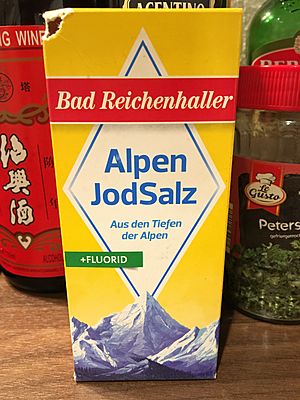
There are different ideas about the best way to prevent tooth decay in a community. The Australian government says water fluoridation is the most effective way to give fluoride to everyone. The European Commission says there's "No obvious advantage" of water fluoridation over using fluoride on teeth directly. Other fluoride therapies also work well to prevent tooth decay. These include fluoride toothpaste, mouthwash, gel, and varnish. Fluoride can also be added to salt and milk. Dental sealants are also effective, preventing 33% to 86% of cavities.
Fluoride toothpaste is the most common and well-studied fluoride treatment. Its invention is seen as the main reason for the drop in tooth decay in developed countries. Toothpaste seems to be the one thing that all countries with lower decay rates have in common. In many low-income countries, toothpaste is the only practical fluoride strategy. This is because they don't have the systems for water or salt fluoridation. However, using toothpaste depends on individual and family habits. Poorer people are less likely to use it. Fluoride toothpaste prevents about 25% of cavities in young permanent teeth. It works even better with higher fluoride amounts or if brushing is supervised. Fluoride mouthwash and gel work about as well as toothpaste. Fluoride varnish prevents about 45% of cavities. Brushing with non-fluoride toothpaste has little effect on cavities.
Adding fluoride to salt works about as well as water fluoridation. This is true if most salt for people to eat has fluoride. Fluoridated salt can be found in homes, schools, and large kitchens. For example, Jamaica started fluoridating all salt in 1987 and saw a drop in cavities. In Switzerland and Germany, fluoridated salt makes up 65% to 70% of the salt sold for home use.
Milk fluoridation is used in some parts of the world, like Bulgaria and Chile. The fluoride is added to milk, powdered milk, or yogurt. These programs are for children and haven't been studied for adults. A study found some evidence to support this practice, but more research is needed.
Other public health ways to control tooth decay, like education about diet, haven't shown great results. Fluoride is the only well-known agent that controls how fast cavities develop. Some suggest adding calcium to water could further reduce cavities. Other agents to prevent tooth decay include antibacterials and sugar substitutes like xylitol. Xylitol chewing gum is recommended as a supplement if it's not too expensive.
A 2007 Australian study said that water fluoridation is the most effective and fair way to give fluoride to whole communities. A 2002 U.S. study estimated that sealants reduced cavities by about 60%. Fluoride reduced them by about 18–50%. A 2007 Italian study suggested that water fluoridation might not be needed, especially in developed countries where cavities are rare. It concluded that toothpaste and other direct fluoride uses are the best way to prevent cavities worldwide. A 2004 World Health Organization study said that water fluoridation has big advantages in preventing tooth decay, especially for groups at high risk. This is true when it's possible and accepted by the culture.
Where Fluoridation Is Used Worldwide
As of November 2012, about 378 million people worldwide received artificially fluoridated water. Most of these people lived in the United States. About 40 million people worldwide drank water that was naturally fluoridated to the right levels.
Much of the early research on fluoride and dental health was done by scientists in the U.S. in the early 1900s. The U.S. was the first country to widely add fluoride to public water. It has been introduced to different degrees in many other countries. These include Argentina, Australia, Brazil, Canada, Chile, Colombia, Hong Kong, Ireland, Israel, and the UK. In 2004, about 13.7 million people in western Europe and 194 million in the U.S. drank artificially fluoridated water. In 2010, about 66% of the U.S. population on public water systems received fluoridated water.
Naturally fluoridated water is used by about 4% of the world's population. This includes countries like Argentina, France, Mexico, and the U.S. In some places, like parts of Africa, China, and India, natural fluoride levels are higher than recommended.
Some communities have stopped water fluoridation. This includes places in Finland, Germany, Japan, and Switzerland. These changes were sometimes due to political opposition. But sometimes, other ways to get fluoride were used instead. Fluoride in different forms is key to preventing tooth decay across Europe. Several countries have started using fluoridated salt. In Switzerland and Germany, fluoridated salt makes up 65% to 70% of the home market.
When Israel started a Dental Health Promotion Program in 2014, they decided that mandatory water fluoridation was no longer needed. They said that providing fluoridated water forces people who don't want it to drink it. This approach is not accepted in most countries.
History of Water Fluoridation
The history of water fluoridation has three main periods. The first (around 1801–1933) was about finding the cause of a type of mottled tooth enamel called the Colorado brown stain. The second (around 1933–1945) focused on how fluoride levels, fluorosis, and tooth decay were related. It showed that moderate fluoride levels prevent cavities. The third period, from 1945 onwards, focused on adding fluoride to community water supplies.
In the early 1800s, researchers found that fluoride was in teeth, bone, and drinking water. Later, they thought fluoride might protect against tooth decay. They suggested adding fluoride to diets. They also saw mottled enamel (now called severe dental fluorosis) without knowing why. In 1874, a German health officer suggested potassium fluoride supplements to protect teeth. In 1892, a British doctor said that a lack of fluoride in diets led to teeth that easily decayed. He suggested adding fluoride back into our diet.
The idea of water fluoridation in the U.S. came from the research of dentist Frederick McKay. McKay spent 30 years studying the Colorado brown stain. This stain made teeth mottled but also cavity-free. With help from G.V. Black, he found that fluoride caused the stain. The first report linking the stain to less tooth decay was in 1925 by UK dentist Norman Ainsworth. In 1931, a chemist found that fluoride was the common factor in water from areas with the staining.

In the 1930s and early 1940s, H. Trendley Dean and others at the U.S. National Institutes of Health published studies. They suggested that about 1 mg/L of fluoride was linked to much fewer cavities in temperate climates. They also found it increased fluorosis, but only to a level that wasn't a medical or appearance concern. Other studies found no other major bad effects, even with fluoride levels as high as 8 mg/L.
To test if adding fluoride would prevent cavities, Dean and his team started an experiment. They added fluoride to the water in Grand Rapids, Michigan, on January 25, 1945. The results, published in 1950, showed a big drop in cavities. Other important early studies outside the U.S. also reported big drops in tooth decay. These included studies in Canada, the Netherlands, New Zealand, and the U.K. These early studies were simple by today's standards. But the large reduction in cavities convinced public health experts of the benefits of fluoridation.
By 1951, fluoridation became an official policy of the U.S. Public Health Service. By 1960, water fluoridation was widely used in the U.S., reaching about 50 million people. By 2006, 69.2% of the U.S. population on public water systems received fluoridated water. This was 61.5% of the total U.S. population. In some other countries, the pattern was similar. New Zealand, which had very bad teeth, started fluoridation in 1953. By 1968, 65% of people with piped water used it.
In other places, fluoridation was used and then stopped. In Kuopio, Finland, it was stopped because school dental services provided enough fluoride. In Basel, Switzerland, it was replaced with fluoridated salt.
McKay's work showed that fluorosis happened before teeth came in. Dean and his team thought that fluoride's protection against cavities also happened before teeth came in. This idea was wrong but accepted for years. By 2000, however, scientists understood that fluoride works best on the surface of teeth. They learned that a constant low level of fluoride in the mouth helps prevent cavities.
Costs and Benefits
Fluoridation costs about $1.26 per person each year on average. Larger water systems have lower costs per person. The cost also depends on how many places fluoride is added, the equipment used, the fluoride chemical, and staff expertise. In rich countries, the cost of salt fluoridation is also very low. But developing countries might find it too expensive to import the fluoride.
In comparison, fluoride toothpaste costs about $11–$21 per person each year. Dental cleaning and applying fluoride varnish or gel costs about $116 per person each year. Even in the worst case, with the lowest effectiveness and highest costs for small cities, fluoridation costs about $19–$30 for each tooth surface saved from decay. This is much lower than the $114 it costs to fix that surface. It's also lower than the $193 average lifetime cost of a decayed surface, which includes keeping the tooth fixed.
A 1989 workshop said that water fluoridation is one of the few public health actions that save more money than they cost. However, there hasn't been much high-quality research on how cost-effective it is. Dental sealants only save money when used on children and teeth at high risk. A 2002 U.S. study estimated that water fluoridation saves money when tooth decay is common. In the U.S., water fluoridation is more cost-effective than other ways to reduce tooth decay in children. A 2008 study said that water fluoridation is the best tool to fight cavities in many countries, especially for disadvantaged groups. A 2016 study found that water fluoridation in the U.S. was cost-effective, especially in larger communities.
U.S. data from 1974 to 1992 showed that when water fluoridation started in a community, there were fewer dental employees and dental offices. This suggests that some dentists moved to non-fluoridated areas or became specialists.
Images for kids
-
A mild case of dental fluorosis, visible as white streaks on the subject's upper right central incisor.
See also
 In Spanish: Fluoración del agua potable para niños
In Spanish: Fluoración del agua potable para niños
- Water fluoridation by country
- History of water supply and sanitation




